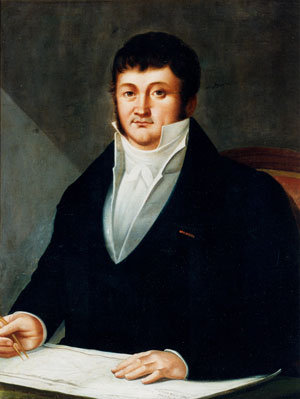
Robert Surcouf was a French privateer, businessman and slave trader who operated in the Indian Ocean from 1789 to 1808 during the French Revolutionary and Napoleonic Wars. Capturing over 40 prizes, he later amassed a large fortune from a variety of commercial activities, such as ship-owning, privateering, slave trading and owning land.

Jean-Baptiste Perrée was a French Navy officer and Rear-admiral.

The Redoutable was a Téméraire-class 74-gun ship of the line of the French Navy. She took part in the battles of the French Revolutionary Wars in the Brest squadron, served in the Caribbean in 1803, and duelled with HMS Victory during the Battle of Trafalgar, killing Vice Admiral Horatio Nelson during the action. She sank in the storm that followed the battle.
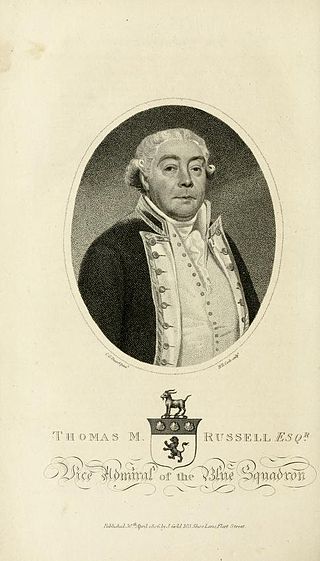
Thomas McNamara Russell was an admiral in the Royal Navy. Russell's naval career spanned the American Revolutionary War, French Revolutionary War and Napoleonic War.

Jean-Marthe-Adrien L'Hermite was a French sea captain and rear admiral, notable for his involvement in the Glorious First of June and his expedition into the Atlantic in 1805.

Jean-Baptiste Philibert Willaumez was a French naval officer and nobleman who served during the French Revolutionary Wars and Napoleonic Wars. Willaumez joined the French Navy at the age of 14, and proved to be a competent sailor. Having risen to the rank of pilot, he started studying navigation, attracting the attention of his superiors up to Louis XVI himself. Willaumez eventually became an officer and served under Antoine Bruni d'Entrecasteaux in his expedition to rescue Jean-François de Galaup, comte de Lapérouse and explore the Indian Ocean and Oceania.

Sibylle was a 38-gun Hébé-class frigate of the French Navy. She was launched in 1791 at the dockyards in Toulon and placed in service in 1792. After the 50-gun fourth rate HMS Romney captured her in 1794, the British took her into service as HMS Sybille. She served in the Royal Navy until disposed of in 1833. While in British service, Sybille participated in three notable single-ship actions, in each case capturing a French vessel. On anti-slavery duties off West Africa from July 1827 to June 1830, Sybille captured many slavers and freed some 3,500 slaves. She was finally sold in 1833 in Portsmouth.
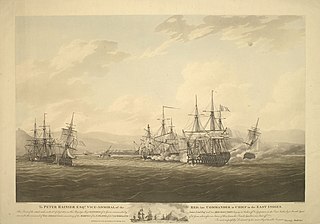
HMS Centurion was a 50-gun Salisbury-class fourth rate of the Royal Navy. She served during the American War of Independence, and during the French Revolutionary and Napoleonic Wars.
Sir James Lind KCB was an officer of the Royal Navy who served during the American War of Independence and the French Revolutionary and Napoleonic Wars. The son of James Lind, a distinguished naval physician, Lind also embarked on a career at sea, but served in a more front line role. After serving on a number of different ships he finally received his own command in 1800, but his first chance to show his ability came only in 1803 when in command of HMS Sheerness. Here he captured a French privateer after his imitation of a merchant ship encouraged the privateer to actually attack his heavily armed frigate. He then revealed the true nature of his ship and the hapless privateer had no choice but to swiftly surrender. Promoted to command the 50-gun HMS Centurion Lind had another opportunity to distinguish himself, when the convoy under his protection was attacked in the harbour of Vizagapatnam by a heavily armed French squadron under Rear-Admiral Charles-Alexandre Durand Linois. Despite being on shore at the time Lind hurried back to take command and supervise operations to resist the French, who though were able to capture one of the merchants, decided not to risk pressing the attack on the Centurion and withdrew. The survival of the Centurion in the face of overwhelming forces was hailed as a great achievement back home in Britain, with Lind being knighted for his efforts.

The action of 28 June 1803 marked the opening shots of the Blockade of Saint-Domingue after the collapse of the Treaty of Amiens and the outbreak of the War of the Third Coalition in May 1803.
Pierre-Louis Lhermite was a French sea captain and rear admiral.

Hubert Le Loup de Beaulieu, often written Beaulieu-Leloup, was a French East India Company and later Navy officer. He was a cousin to Louis Garneray.
Charles-Marie Cunat was a French naval officer, privateer and naval historian.
Andromaque was a 32-gun Nymphe-class frigate of the French Navy.
The action of 7 June 1780 took place during the American War of Independence between the frigates Hermione and HMS Iris. The ships exchanged fire for one hour and a half before parting. The battle resumed in written form when James Hawker published his account of the battle in a newspaper, which Louis-René Levassor de Latouche Tréville contested heatedly.

Théobald-René, Comte de Kergariou-Locmaria was a French Navy officer and Royalist émigré.
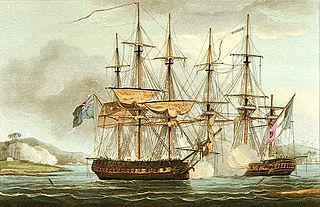
The Battle of Mahé was a minor naval engagement of the last year of the French Revolutionary Wars, fought on 19 August 1801 in the harbour of Mahé in the Seychelles, a French colony in the Indian Ocean. Since the demise of the French Indian Ocean squadron in 1799, the Royal Navy had maintained dominance in the East Indies, controlling the shipping routes along which trade flowed and allowing the rapid movement of military forces around the theatre. French First Consul Napoleon Bonaparte had long-harboured ambitions of threatening British India, and in 1798 had launched an invasion of Egypt as an initial step to achieving this goal. The campaign had failed, and the French army in Egypt was under severe pressure by early 1801, partly due to the presence of a British squadron acting with impunity in the Red Sea.

The action of 28 February 1799 was a minor naval engagement of the French Revolutionary Wars, fought off the mouth of the Hooghly River in the Bay of Bengal between the French frigate Forte and the Royal Navy frigate HMS Sybille. Forte was an exceptionally large and powerful ship engaged on a commerce raiding operation against British merchant shipping off the port of Calcutta in British India. To eliminate this threat, Sybille was sent from Madras in pursuit. Acting on information from released prisoners, Edward Cooke, captain of Sybille, was sailing off Balasore when distant gunfire alerted him to the presence of Forte on the evening of 28 February. The French frigate was discovered at anchor in the sandbanks at the mouth of the Hooghly with two recently captured British merchant ships.
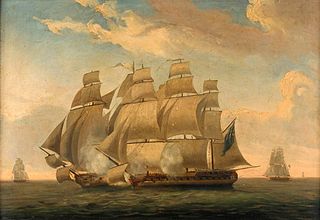
The action of 2 January 1783 was a minor naval battle that took place in the Caribbean Sea during the last stages of the American War of Independence. Severe fighting between a Royal Navy frigate HMS Magicienne and a French frigate Sibylle went on for nearly two hours, but in that time both frigates were reduced to wrecks.
Sibylle was a 32-gun copper-hulled, frigate of the French Navy, lead ship of her class.













